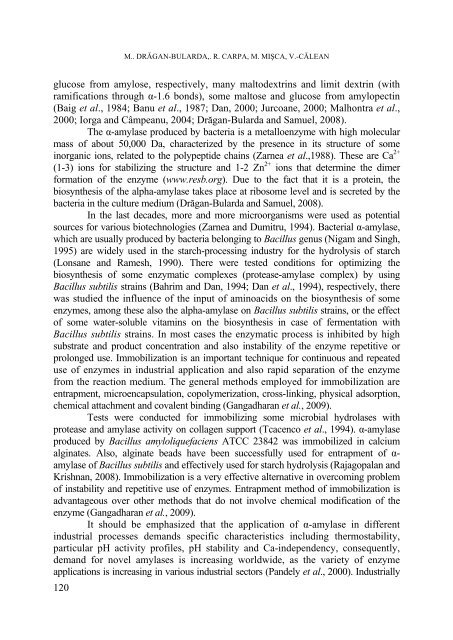biologia - Studia
biologia - Studia
biologia - Studia
You also want an ePaper? Increase the reach of your titles
YUMPU automatically turns print PDFs into web optimized ePapers that Google loves.
M.. DRĂGAN-BULARDA,. R. CARPA, M. MIŞCA, V.-CĂLEAN<br />
glucose from amylose, respectively, many maltodextrins and limit dextrin (with<br />
ramifications through α-1.6 bonds), some maltose and glucose from amylopectin<br />
(Baig et al., 1984; Banu et al., 1987; Dan, 2000; Jurcoane, 2000; Malhontra et al.,<br />
2000; Iorga and Câmpeanu, 2004; Drăgan-Bularda and Samuel, 2008).<br />
The α-amylase produced by bacteria is a metalloenzyme with high molecular<br />
mass of about 50,000 Da, characterized by the presence in its structure of some<br />
inorganic ions, related to the polypeptide chains (Zarnea et al.,1988). These are Ca 2+<br />
(1-3) ions for stabilizing the structure and 1-2 Zn 2+ ions that determine the dimer<br />
formation of the enzyme (www.resb.org). Due to the fact that it is a protein, the<br />
biosynthesis of the alpha-amylase takes place at ribosome level and is secreted by the<br />
bacteria in the culture medium (Drăgan-Bularda and Samuel, 2008).<br />
In the last decades, more and more microorganisms were used as potential<br />
sources for various biotechnologies (Zarnea and Dumitru, 1994). Bacterial α-amylase,<br />
which are usually produced by bacteria belonging to Bacillus genus (Nigam and Singh,<br />
1995) are widely used in the starch-processing industry for the hydrolysis of starch<br />
(Lonsane and Ramesh, 1990). There were tested conditions for optimizing the<br />
biosynthesis of some enzymatic complexes (protease-amylase complex) by using<br />
Bacillus subtilis strains (Bahrim and Dan, 1994; Dan et al., 1994), respectively, there<br />
was studied the influence of the input of aminoacids on the biosynthesis of some<br />
enzymes, among these also the alpha-amylase on Bacillus subtilis strains, or the effect<br />
of some water-soluble vitamins on the biosynthesis in case of fermentation with<br />
Bacillus subtilis strains. In most cases the enzymatic process is inhibited by high<br />
substrate and product concentration and also instability of the enzyme repetitive or<br />
prolonged use. Immobilization is an important technique for continuous and repeated<br />
use of enzymes in industrial application and also rapid separation of the enzyme<br />
from the reaction medium. The general methods employed for immobilization are<br />
entrapment, microencapsulation, copolymerization, cross-linking, physical adsorption,<br />
chemical attachment and covalent binding (Gangadharan et al., 2009).<br />
Tests were conducted for immobilizing some microbial hydrolases with<br />
protease and amylase activity on collagen support (Tcacenco et al., 1994). α-amylase<br />
produced by Bacillus amyloliquefaciens ATCC 23842 was immobilized in calcium<br />
alginates. Also, alginate beads have been successfully used for entrapment of α-<br />
amylase of Bacillus subtilis and effectively used for starch hydrolysis (Rajagopalan and<br />
Krishnan, 2008). Immobilization is a very effective alternative in overcoming problem<br />
of instability and repetitive use of enzymes. Entrapment method of immobilization is<br />
advantageous over other methods that do not involve chemical modification of the<br />
enzyme (Gangadharan et al., 2009).<br />
It should be emphasized that the application of α-amylase in different<br />
industrial processes demands specific characteristics including thermostability,<br />
particular pH activity profiles, pH stability and Ca-independency, consequently,<br />
demand for novel amylases is increasing worldwide, as the variety of enzyme<br />
applications is increasing in various industrial sectors (Pandely et al., 2000). Industrially<br />
120
















